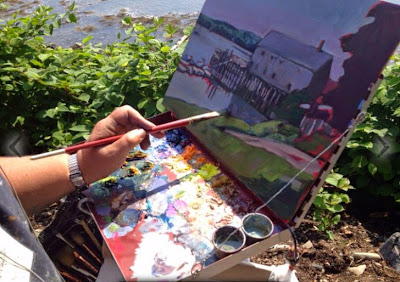We humans really have no idea how tiny we are compared to nature.
|
Towering Elm, Carol L. Douglas, painted at Castine Plein Air
|
Trees are the largest living beings surrounding us, but we pay them scant attention. Until one drops a limb, we have no sense of their power or scale. Most of us can’t identify more than one or two species. Gardeners may fuss over the flowering trees, but they pay scant attention to the large masses of green just beyond their fences.
There are about 3.04 trillion trees on Earth, or around 422 for each person. It seems like we ought to pay more attention to them.
As with everything visual, my ‘knowledge’ sometimes overwrites what I see. I told you how I once repeatedly mis-corrected a student’s drawing of a lobster boat. Being able to draw something from memory is a skill. The downside is when we stop observing altogether.
I had a similar epiphany last week in Castine. I’d seen Don Tenney of the Castine Arts Associationover the winter. He told me about a survey map of elms in the town.
 |
|
Photo of Delaware Avenue near Summer Street, 1939, by Wilbur H. Porterfield, courtesy Buffalo and Erie County Historical Society.
|
“Elms?” I asked, disbelieving. I’m from Buffalo, where Dutch Elm Disease first appeared in 1951. By the late 1960s, almost every elm was dead. Buffalo, once known as the City of Trees, lay bare, its Cathedral Arches of about 180,000 trees gone forever. I was a small girl when the city arborists cut down the remaining trees on our block. It went from a magical green tunnel to an unremarkable, clapped-out neighborhood instantly.
I assumed the elms were gone everywhere, gone the way of the American chestnut, into the annals of history.
Dutch Elm Disease arrived in the US in 1928. Of an estimated 77 million elms in North America in 1930, over 75% were gone by 1989. But it turns out there are remaining pockets of elms, most notably in Canada’s western provinces. And there are still a lot of them in Castine.
Once I realized they were there, I couldn’t stop seeing them. They’re even taller and statelier than in my memory. They’re no longer in an unbroken line, except for a stretch of Court Street, but they still arch over Castine’s lovely streets.
In Republic of Shade: New England and the American Elm, Thomas J. Campanella documents the importance of the American elm to our American identity. Elms were planted in formation across the country.
 |
|
The Elm Tree, c. 1880, George Inness, courtesy of the Clark Museum.
|
Dutch Elm Disease notwithstanding, elms were hardy and long-lived. They have a dense canopy with a unique parasol shape, echoing a vase or the Gothic arch. Since they had no commercial usefulness, they were allowed to grow untouched on the edges of fields and in the forest. They came to represent the primeval forest in the American imagination.
I painted the above example of an elm at the corner of State and Court Streets as dusk fell. Next year, I’ll approach the composition differently. But this painting was useful in setting the scale of the trees. I had to erase the house repeatedly and make it smaller to make it true to reality. We humans really have no idea how tiny we are compared to nature.
I’ve got one more workshop available this summer. Join me for Sea and Sky at Schoodic, August 5-10. We’re strictly limited to twelve, but there are still seats open.










